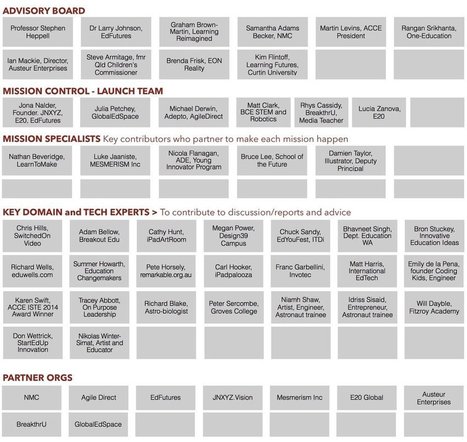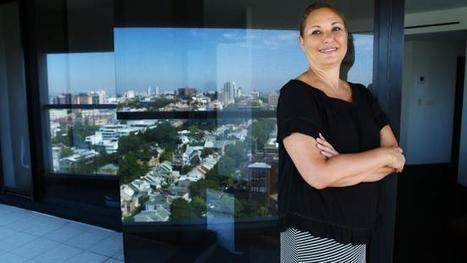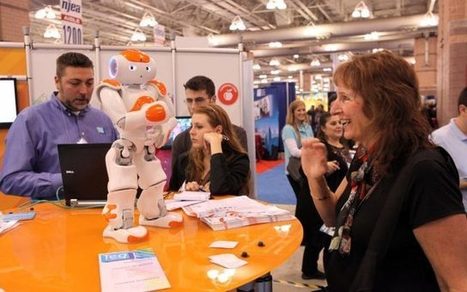 Your new post is loading...
 Your new post is loading...

|
Scooped by
Kim Flintoff
April 5, 2017 8:42 PM
|
The practical role performing arts plays in a well-rounded holistic educational experience has been the subject of much debate over the years. It’s refreshing to see that it is receiving more attention than it has in the past. Educators are more aware of its intrinsic value in curriculums across the world. It’s more than just role-playing or doing a little dance; it’s about learning versatile, transferable life skills that matter.
Besides the fact that it’s fun and challenging, it builds habits of mind that are essential to living well and weathering the adversities of everyday life. It hones our creativity and intelligence, fosters our compassion, and brings a higher understanding of humanity to our awareness. Performers have to be critical thinkers, problem solvers, and good listeners.

|
Scooped by
Kim Flintoff
April 2, 2017 9:33 PM
|
A wordless film by two Spanish filmmakers follows a father and son as they struggle for happiness in spite of crushingly bleak capitalist forces.
https://vimeo.com/194276412

|
Scooped by
Kim Flintoff
March 31, 2017 8:16 PM
|
EXECUTIVE SUMMARY
Higher education leaders today confront a bevy of criticisms ranging from worsening affordability and persistent socioeconomic disparities to a lack of relevance in the ever-changing economy. Institutions are beset by internal challenges and external pressures. Business models are cracking under enormous pressure as state appropriations decline and net tuition growth wanes. Business as usual simply can’t continue.
The nature of competition in higher education is changing—presenting both challenges and opportunities. For decades—centuries, even—higher education has been on a continuous trajectory of developing more complex and comprehensive institutions to build and disseminate knowledge and educate students. But technology is enabling a new, disruptive path: simpler, more affordable, more accessible educational experiences, built in alignment to the needs of the workforce. Leaders can look to examples of institutions that are successfully innovating in the new environment, some along this new disruptive path, and others by incorporating disruptive technologies to move forward along the traditional trajectory:

|
Scooped by
Kim Flintoff
March 31, 2017 2:38 AM
|
TEAM PIONEERS
There are already pockets of educators, experts and ‘Edunauts’ who are ahead of the curve and working to aid a transition to a successful tomorrow > FUTURE-U is committed to nurturing these experts, researchers and mars-shot thinkers, and is grateful to have their support in making the mission happen:

|
Scooped by
Kim Flintoff
March 27, 2017 6:33 PM
|
From its founding in 2012 with an "Invitation 2 Innovate" (i2i), to the premier this week of a new conference on open innovation, Lone Star College-University Park has innovation in its DNA. It's the newest of seven community colleges that make up Lone Star College, and it has a clearly articulated plan to be a leader in innovation. Here, CT speaks with Lone Star College-University Park's chief strategist for innovation and research.

|
Scooped by
Kim Flintoff
March 16, 2017 7:51 PM
|
Recently it seems that innovation is a buzzword on the tip of everyone’s tongue. Need happier employees? Innovate! Need bigger profits? Innovate! Need better leadership? Innovate!
Over the past six months I’ve explored hundreds of news stories, white papers, and blog posts focused on why and how leaders might foster a culture of innovation. Unfortunately, innovation is too often be touted as a silver bullet solution without even defining what innovation is. Some folks have taken a stand against innovation, given its use as a catchall strategy. Yet I stand firmly in support of innovation as a focus for making better organizations and happier teams. I believe that what is most important is not that we “innovate” for innovation’s sake, but that we create cultures of innovation in our organizations -- cultures that supports risk-taking, reflection, and real collaboration. Out of the hundreds of strategies for and stories of innovation, I believe there are ten key lessons we can draw out to support us in creating cultures of innovation in schools and districts. Why ten lessons? David Letterman, obviously.

|
Scooped by
Kim Flintoff
February 16, 2017 3:19 AM
|
Key Takeaways
As efforts to stimulate innovation spring up across campuses, institutions need a comprehensive planning framework for integrated planning of initiatives to support innovation.
Viewing the campus as an Innovation Landscape, settings for collaborative creative activity — both physical and virtual — infuse the campus fabric and become part of the daily experience of their users.
The Innovation Landscape Framework proposed here serves as a tool that can help coordinate physical planning with organizational initiatives, engage a wide range of stakeholders, and enable a culture of innovation across campus.

|
Scooped by
Kim Flintoff
February 7, 2017 9:03 PM
|
Here are three links worth your time:
Those old jobs are gone forever. Let’s gear up for what’s next. (7 minute read)
A data scientist played 4,7000 game of Hearthstone, then built beautiful data visualizations of them. (6 minute read)
Mathematical genius is fragile. We need to stop destroying it. (6 minute read)
Bonus: IMDb is shutting down its forums. Here’s how one developer designed them back in 2001. (30 minute read)

|
Scooped by
Kim Flintoff
February 6, 2017 8:15 PM
|
What do you get when you give a design tool a digital nervous system? Computers that improve our ability to think and imagine, and robotic systems that come up with (and build) radical new designs for bridges, cars, drones and much more — all by themselves. Take a tour of the Augmented Age with futurist Maurice Conti and preview a time when robots and humans will work side-by-side to accomplish things neither could do alone.

|
Scooped by
Kim Flintoff
February 4, 2017 6:42 PM
|
When schools try to innovate, they often take a traditional top-down approach: devise a strategy, roll it out to teachers and support a high-fidelity implementation. The end result is often one that lacks teacher support or genuine enthusiasm — initiatives putter along and change is sporadic or modest.
In education and beyond, innovation is usually the result of iteration rather than central planning. In schools that succeed in implementing real instructional improvements, teachers figure out how to improve teaching and learning by journeying through multiple passes of a cycle of experiment, reflection and adjustment.
If a school leader’s goal is to implement thoughtful innovation, one way to think about school leadership, therefore, is to think about how to help teachers move through that cycle of iteration and innovation more effectively, more efficiently and more joyfully. Administrators have four powerful places where they can “grease the gears” of this cycle: creating an R&D budget, supporting opportunities for team learning, creating spaces for broader teacher sharing and learning, and building consensus around a shared vision and shared instructional language.

|
Rescooped by
Kim Flintoff
from Edumorfosis.it
January 30, 2017 6:36 PM
|
By 2020 Millennials will make up over a third of the global workforce. That’s one reason so many reports about them exist. Some say they are disloyal, self-absorbed and lazy, while others claim they’re a generation of digital entrepreneurs and innovators. Some aim to dispel the myths others have created. Just type “Millennials are...” into a Google search to see the stereotypes.
This is not just another Millennial report. This report presents new findings with fresh insights from the perspective of both employers and employees. As world of work experts, we have nearly 30,000 employees advising 400,000 clients on hiring decisions and talent development every year. We find work for 3.4 million people—about half of whom are Millennials.
We carried out quantitative research across 25 countries surveying 19,000 Millennials, including 8,000 ManpowerGroup associate employees and more than 1,500 of our own hiring managers. We asked what they look for in a job, what development opportunities they seek and what would make them stay with an employer. We wanted to understand how different they are or aren’t from the rest of the workforce and from generations before them. We wanted to ensure that the sample represented all working Millennials; not just the top percent of tech-savvy earners, but also the graduates and non-graduates across all industries, income and education levels.
Via Edumorfosis

|
Scooped by
Kim Flintoff
January 20, 2017 8:15 PM
|
The battle between VHS and Betamax for mastering the video format is just one example of the challenges of some technological advances. Each new program, technique, and methodology has its own way of working, and when several options for the same function arise, a struggle takes place until one is imposed. In the construction sector new methodologies are being born, one of them is the already well-known Building Information Modeling or BIM, which consists of the process of generating and managing data of a building during its life cycle.
Thanks to the advantages, the association Building Smart has flagman to become the common framework and all the tools in the industry adapt to it. That is, BIM becomes the lingua franca of construction. For this it is necessary to develop and spread open standards, and that is just what the association is dedicated to. For president in Spain, Sergio Muñoz , this work is vital to ensure the expansion of this way of working. From Building Smart explains, they develop them , but then they are agencies standardization and certification as AENOR who launch them for the entire industry to join them.

|
Scooped by
Kim Flintoff
January 15, 2017 7:38 PM
|
Running out of ideas might be the biggest fear for anyone- especially a creative person. After all, if you don't have new ideas, what do you have?
It is impossible to run out of creativity. It's important to seek creation, break the rules, bring solutions to your problem areas, and grab people's attention. Ideas are about picking a path which piques your interest and starting forward with confidence.
With this step-by-step guide, learn how to:
Create the correct mindset
Build the right habits
Apply your mindset and habits in all areas
Bonus: Creative exercises
You have it in you to generate infinite ideas. All you need is a path to follow...
Offered Free by: Todd Brison
|

|
Scooped by
Kim Flintoff
April 4, 2017 7:31 PM
|
I offered my oldest the very prestigious “Altucher Fellowship”. Never awarded before. Only awarded to her. Always send people to the best resource. Even if it’s a competitor. The benefit to you comes…

|
Scooped by
Kim Flintoff
March 31, 2017 8:17 PM
|
A study last month on the high costs of online learning grabbed headlines. According to a survey by WCET, higher education institutions’ distance learning programs appeared no cheaper, and in some cases reported being even more expensive, than traditional face-to-face instruction.
This finding bucks the conventional wisdom that online learning is always cheaper. Logically speaking, it ought to be cheaper: delivering lectures and content online lends itself to lowering labor costs, generating efficiencies in assessment, and scaling at a fraction of the cost of face-to-face instructional models.

|
Scooped by
Kim Flintoff
March 31, 2017 8:15 PM
|
As schools innovate and transform what teaching and learning look like on their campuses, the design of academic buildings is likely to change in dramatic ways as well. Classrooms and lecture halls may, over time, fade away and become relics of our educational past.
Bryant University, a private university located in Smithfield, R.I., with academic programs that integrate business and the arts and sciences with a global perspective, offers a glimpse of what the future of campus design could look like. Its new Academic Innovation Center (AIC) opened just this past fall.
The Center provides spaces for innovative and interdisciplinary teaching and learning where students can learn in novel formats, develop and prototype new products and services through a design-thinking approach, and collaborate. The goal is to bolster students’ capacity for innovation and creativity.

|
Scooped by
Kim Flintoff
March 27, 2017 6:34 PM
|
There are huge opportunities for bottom-up innovation in regional cities and local council areas, but only if communities can overcome skills and capability shortfalls to make sense of the digital data resources available to them.
Things are never this simple, of course. But if you can at least view newly available digital data as a key component for evidence-based decision-making, then you can start looking at the kinds of governance frameworks that will enable that data to be more easily turned into knowledge and insight.
When we think of cities we tend to think of geographic boundaries. But communities are different; they are bound by more than geography. People can belong to more than one community.

|
Scooped by
Kim Flintoff
March 19, 2017 7:58 PM
|
A lot of my work, in both public speaking and private consulting, is rooted in foresight and anticipatory research. Unlike “futurology” I’m less interested in predicting the future than anticipating…

|
Scooped by
Kim Flintoff
February 17, 2017 5:52 PM
|
While that system may work in business, Carroll draws from a main tenant of activism for her philosophy on designing for social change: that the communities that are impacted the most by a movement should have a prominent place in leading the movement. "You cannot say that you are effectively addressing these issues if you are not including the people affected by them into your efforts, and giving them access to power," Carroll says. To come up with community-led responses to racial inequity in St. Louis, CRXLAB not only consults with the black and Latino communities who experience that inequity; they are the people participating in the workshops, benefiting from the resources, and building out their ideas.
One example of that is a new initiative from CRXLAB called Design to Better [Our City], which will adapt the 24-hour workshop formula to a longer-term curriculum for middle- and high-school kids during the school year that will bring designers, business people, and legislators together to teach students about creative problem solving. Carroll says CRXLAB opted to make the program, which will begin in 2018, an after-school one so that it would bring together kids of all races, even as the St. Louis school system remains largely segregated due to districting. Last month, the initiative became a finalist for the Knight Foundation's Knight Cities Challenge, and if it becomes a recipient of the grant in June CRXLAB will expand it to Detroit and Miami.
For most of the students—the program begins with seventh graders—it will be the first time they've learned about design or been given access to tools for things like building a website or designing an app. It will also be an opportunity for them to use their backgrounds, learned experiences, and specific insights into their own communities to develop new ideas—not to be used by an experienced designer, but for them to develop and put into place themselves. It's easy to imagine how something like this could benefit a student as she goes on through high school and graduates with an idea for a nonprofit or digital product that will directly address the issues she and her community know well.

|
Scooped by
Kim Flintoff
February 12, 2017 5:05 PM
|
The idea that robots could replace humans in the workplace dates back to science fiction writers a century ago, and it has been a recurring theme in

|
Scooped by
Kim Flintoff
February 7, 2017 8:59 PM
|
Architectural Design is not a subject normally taught in schools. Because it presents something of a novelty to children, it often produces some very creative and exciting results. Furzedown Primary School in South West London regularly hold a sequence of lessons in its summer term focusing on this with a Year 5 class. The process starts looking at structure and continues with spacial design, materials, drawing techniques followed by model making. The children are normally given a brief and asked to design a pavilion. To conclude the sequence of lessons, a selection of projects is chosen to build full scale.
Because the subject is seen as a novelty, it gives an opportunity to experiment and play with ideas, while still addressing many relevant areas of the National Curriculum and the school’s targets for child development. The architecture lessons draw connections between the artistic and cultural-based subjects, and technically-oriented subjects such as Maths and Science. The children apply their knowledge of these implicitly to their ideas and creations, and combine them into a single focus.

|
Scooped by
Kim Flintoff
February 5, 2017 6:20 PM
|
However, according to the World Economic Forum, we have entered the Fourth Industrial Revolution - an era marked by exponentially faster rates of change than we have ever experienced before. With the potential for the adoption curve to become significantly steeper, how do we prepare our students to recognize and prevent the unintended consequences of new technological advancements?
Rogers explains that innovators often bring their own cultural bias when pioneering a new innovation. Introducing a snowmobile without first understanding the symbiotic nature of the herders and reindeers could be attributed to a bias towards technology as well as a lack of empathy for the people. In The Triple Focus, Peter Senge describes the need for students to develop three types of empathy:
Cognitive empathy - understanding the perspectives of others
Emotional empathy - the ability to sense how others feel
Empathic concern - a drive to action for the benefit of others
Strategies such as design thinking, systems thinking, project based learning, and service learning encourage students to seek out authentic problems, consider views other than their own, and actively engage with their broader community. In using them, we provide our students with the opportunity to develop these three forms of empathy as well as critical cognitive and academic skills. With more and more devices entering into our classrooms, we need to make sure that we not only prepare our students with the literacy and fluency to use them but also the empathy and empathic concern to recognize both the benefits and imperfections of new innovations.

|
Scooped by
Kim Flintoff
January 30, 2017 9:43 PM
|
Much of the dialogue emanating from the local sector is encouraging, according to Ms Demsey, who warns local entrepreneurs and venture capitalists to not fall hook, line and sinker for the allure of Silicon Valley.
“The thing about the valley is that everybody is searching for their unicorn and nobody really wants to talk about the carnage,” she said.
“There are lots of good companies that don’t get the attention and die, there’s a lot of human and physical capital that falls by the wayside and I personally think that’s the wrong way to go about things. I am all for building a more sustainable ecosystem where all of the companies move forward.”
The Australian start-up sector, which to some extent is still getting used to being in the limelight, was well positioned to follow a sustainable path to success, as long as entrepreneurs were willing to be patient, Ms Demsey said.

|
Scooped by
Kim Flintoff
January 28, 2017 6:46 PM
|
Research by psychologist Bluma Zeigarnik in 1927, found that you can have a better memory for incomplete tasks than for complete ones. Known as the Zeigarnik effect, Bluma proved that task left unfinished for a period of time helps your ability to retain and recall information.
The results suggested that a desire to complete a task can cause it to be retained in a person’s memory until it has been completed.
Since Zeigarnik’s publication, a lot of other studies were carried out to confirm and replicate her findings.
Makerspaces are creative spaces located in communities, schools, and public and academic libraries. These areas are designed to engage participants in hands-on activities that teach twenty-first-century skills. The emphasis in makerspaces is placed upon educating students in STEAM (science, technology, engineering, and mathematics) subjects as well as digital and information literacy.
According to Kylie Peppler and Sophia Bender in their article, Maker movement spreads innovation one project at a time, the focus of makerspaces is hands-on learning, “A hallmark of the maker movement is its do-it-yourself (or do-it-with-others) mindset that brings together individuals around a range of activities, including textile craft, robotics, cooking, wood-crafts, electronics, digital fabrication, mechanical repair, or creation — in short, making nearly anything.” This focus on hands-on creative learning is one of the reasons why makerspaces are seen by educators as being a key to innovation and an ideal method for equipping students to succeed in the future.
|



 Your new post is loading...
Your new post is loading...











![[PDF] Millennial Carreers: 2020 vision | Learning Futures on I.C.E. - Innovation, Creativity and Entrepreneurship | Scoop.it](https://img.scoop.it/S7zNDnBDucCdDDcdhTAs0Tl72eJkfbmt4t8yenImKBVvK0kTmF0xjctABnaLJIm9)


















